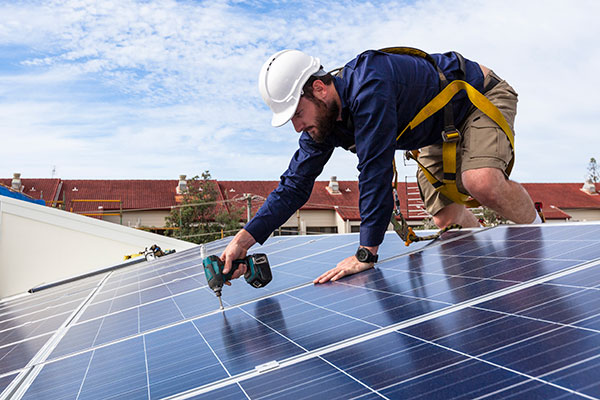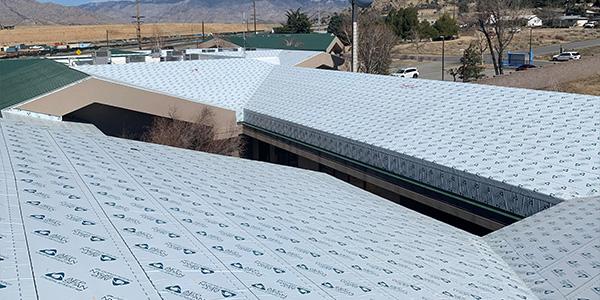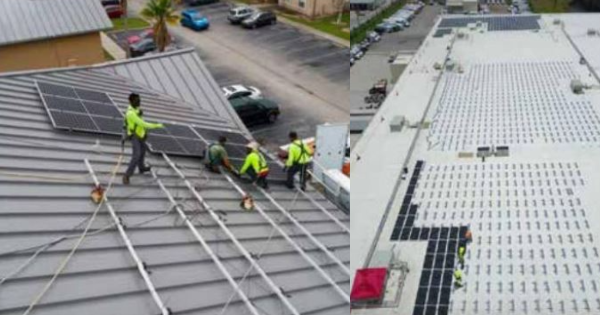Sun Power: Installation Of Solar Panels On Asphalt Roofs

Mounting methods for solar panels on asphalt roofs are important for contractors to understand, especially when dealing with roof penetrations and warranties.
By Atlas Roofing
When Bell Laboratories first introduced its silicon solar cell technology in 1953, solar panels operated at only 4 percent efficiency. What this number means is that only 4 percent of the sunlight energy hitting the solar cells was converted into electricity by the solar photovoltaic process.
Today, solar panels can achieve efficiency ratings as high as 20 percent. Tax incentives have made solar panel installation more attractive to homeowners. And the green energy movement has inspired many to do their part to help move the world toward a future of clean, renewable energy.
Two types of solar cells are currently available for installation on roofs. Generation, or photovoltaic, solar cells generate electricity for home electrical needs. Conservation solar panels are used to heat water without the need for electricity or gas. The water heated by conservation solar panels is often used inside the house or for swimming pools.
Tim Graboski, owner of Tim Graboski Roofing Inc. of Deerfield Beach, FL one of the leading solar solutions specialists in the Southeast, installs both conservation and generation solar panels on commercial and residential structures. A contractor with a strong roofing background, Graboski quickly learned that solar panel installation raised concerns about roof shingle warranties. He dedicated himself to learning and implementing the most durable, most reliable solar panel mounting methods available.
Installation Considerations According to Graboski, to be properly installed on an asphalt roof, solar panels must be mounted on racks attached to the roof deck. Graboski uses a non-penetration system called SnapNRack, but most mounting systems require roof penetration.
Solar Power World Online lists important considerations that contractors need to be aware of when installing panels on roofs, especially when penetration systems are used:
- Always check the roofing manufacturer’s flashing and sealant requirements.
- Use high-quality flashing to prevent moisture intrusion at penetration points. Look for flashing that is resistant to corrosion and will last for the entire lifespan of the solar panels.
- Consider the thickness of the roofing shingles. The wideness of the flashing used in installation must be appropriate to the thickness of the shingle. Flashing with elevated attachment points must be used for thicker, high-quality shingles.
- Don’t allow flashing to extend past the drip edge of the shingles. Always align the bottom edge of flashing with the drip edge of each course of shingles.
- Trim shingles to sit flush with the base of the flashing to avoid disrupting water diversion.
- Do not remove nails from shingles. Some flashing manufacturers recommend removing nails and fasteners that present an obstruction. However, regulations require a minimum number of fasteners.
Paul Casseri, Product Manager of Atlas Roofing Shingles and Underlayment Division, stresses the importance of following panel installation instructions to the letter. “The shingle itself is warrantied, not the installation,” remarks Casseri, “Contractors need to be diligent in their installation of solar panels and make sure to follow instructions closely. The roof is a closed system, and installing panels will create penetration points that must be sealed properly.”
Contractors also should consult local building codes before any solar panels are installed. , he says. For example, some codes prohibit solar panel installation on any street-facing roof plane to avoid negative effects on the home’s curb appeal. Other codes are very specific on roof deck reinforcements beneath the solar panel site.
Casseri, citing an Atlas Roofing 2014 article “Warranties Needed For Rooftop Solar Panels,” says that the current age of a roof should be taken into consideration before committing to a solar panel installation contract. If a roof will need replacing within five years, both roofer and homeowner may want to wait and do both projects at the same time.
Finally, some experts express concern about roof damage from heat buildup underneath the solar panels. According to Solar Gaines, a New England solar panel installation company, the only way heat can accumulate between the panels and the shingles is if debris, birds’ nests, or insect nests accumulate between the roof and the panels and obstruct airflow. Homeowners should contact a roofer to periodically check for debris so airflow is maintained.
As long as there is a gap between the panels and the asphalt shingles, the roof should be fine. The shade produced by the panels, coupled with the free-flowing air, can keep the covered shingles cooler than the ones exposed to direct sunlight. Wire mesh can be installed to protect the gap, but it can also restrict airflow and cause heat buildup.
In The Sunlight With Atlas Roofing Atlas shingles cover many roofs in the Southeast, where homes roofed with solar panels can benefit from longer daylight hours than in Northern states (especially in the winter), and higher levels of solar density (which gives the solar panels more raw sunlight to convert to electricity).
Graboski approaches solar panels from a roofer’s perspective, explaining how dependable, long-lasting solar panels can be installed without compromising the integrity of the underlying roofing system.
Roofing contractors who are considering adding solar panel installation to their catalog of services can learn more about generation (photovoltaic) solar panels and asphalt shingle roofs from the Asphalt Roofing Manufacturers Association.
Contact Atlas Roofing today for more information.



















-2025-xtv-mls-tour-2.png)


Comments
Leave a Reply
Have an account? Login to leave a comment!
Sign In